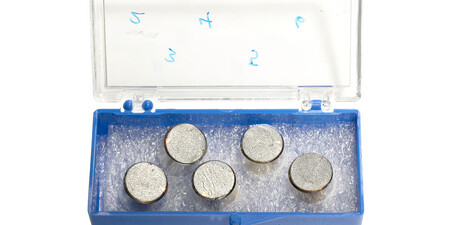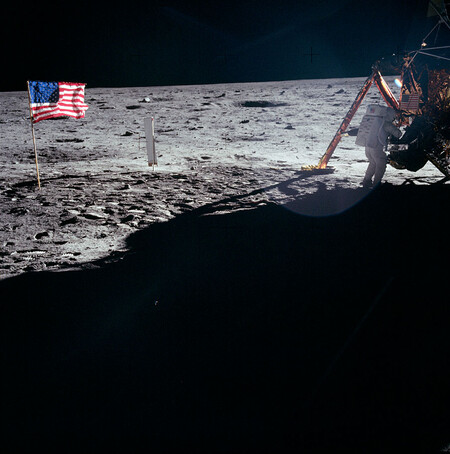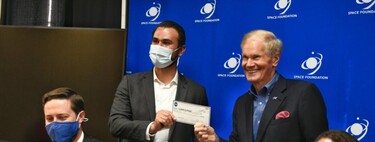NASA sees how one of its most curious monopolies is cracking: that of lunar dust. More specifically, that of the samples collected during the missions of the Apollo Program between the end of the 1960s and the beginning of the 70s. Despite its efforts to prevent it, an effort that has even taken it to court, the US space agency is about to face an uncomfortable episode. In a matter of days, on April 13, the bidding firm Bonhans Actioneers will organize the auction of some of the lunar dust taken by Neil Armstrong in 1969.
It will not be the first time that specks of our natural satellite have been sold, but Bonhans’ quote highlights the fact that the operation will be totally legal and NASA, despite having endorsed the material, has not been able to prevent it from ending up in private hands. How? Well, after a journey worthy of the best intrigue movie. Or a comedy of acid dyes. Its origin goes back more than half a century in time, to 1969, when Armstrong first stepped on the Moon, collected some dust samples and kept them in a bag that, despite its historical value, at that time had no definite purpose.
Once the material reached Earth, NASA, without a clear idea of what it wanted to do with those lunar specks, decided to send them to the Cosmosphere space museum in Kansas. The problem? That, as it was discovered in 2003, the person in charge of the facilities at the time was dedicated to selling pieces from the collection. As a result of that episode, years later the US marshals decided to auction off hundreds of items that had “disappeared” from the shelves of the Kansas museum, including the old bag of space dust collected by Armstrong.
A bag of dust with a lot of travel
If the journey of the lunar motes had not already been gruesome enough, got a little more complicated. Apparently the bid escaped NASA’s radar, but no — details the magazine vox— by Nancy Lee Carlson, a geology buff who decided to pay $995 to get her hands on that odd lot from Kansas. At auction she got the headrest of an Apollo module, a key to the Soyuz T and … the famous bag prepared by Armstrong.
Piqued by curiosity, Carlson did the most logical thing: he contacted NASA to confirm if indeed those were specks from the Moon. In 2015, she sent the bag to the agency with the request that they clarify the origin of the material. After studying it and verifying that its content was indeed real, in Washington they did what they also considered the most logical: they kept it.
Between 1969 and 1972, NASA collected approximately 2,200 samples from the Moon and its maxim, for a long time, was that the specks of the Apollo program were its property. That includes both the material that has always been under his direct supervision and the one that, in cases like that of Nancy Lee Carlson, by chances of life ended up outside the control of the state agency. To resolve such illicit possessions—at least in his opinion—NASA initiates disputes that it usually wins. The problem is that Carlson had bought the material through a completely official and apparently legal channel.

The strips with the moon dust that will be auctioned this month at Bonhams.
This is what she argued in court. And this was also considered by the judge who handled the case, who in 2016 concluded resoundingly and to NASA’s despair that the purchase had been made “in good faith” and the operation had been legal. Carlson ended up selling the Armstrong bag for about $1.8 million in 2017; but that did not put an end to the lunar soap opera. The container contained particles of the precious material, not all of the dust collected in 1969.
Had it evaporated? No. She was just still in the NASA labs. During the tests he did to verify that Carlson’s material was authentic, the agency had sampled small carbon strips and then preserved all of the material. That —recalls Vox— gave rise to another claim in which the agency had to give its arm to twist. Carlson took at least most of the dust, now presented in the aluminum disks used by NASA to observe them with scanning electron microscopes, and put it back up for auction.

Neil Armstrong on the Moon during the Apollo 11 mission.
The result is the lot that will be auctioned in a matter of days in New York by the Bonhans company, which already advertises the box as “the only Apollo sample that can be legally sold.” In total there are five small 10mm diameter discs with the specks taken by Armstrong in 1969, a space “relic” that Bonhans hopes will sell for between 800,000 and 1.2 million dollars. During the same day, a fragment of Sputnik-1 will also be auctioned for between 80,000 and 120,000 dollars and an original model of Explorer I and a map signed by 15 astronauts from the Apollo Program that could add up to around 90,000 dollars together.
Pictures | Bonhams and NASA
George is Digismak’s reported cum editor with 13 years of experience in Journalism
